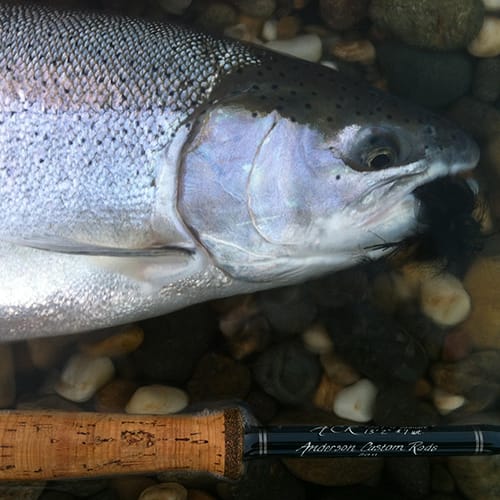American River winter steelhead
American River winter steelhead are an important recreational resource. Construction of Folsom and Nimbus dams on the American River blocked historic runs of Chinook salmon and steelhead. No provisions for fish passage were provided. As an alternative a hatchery was constructed and began operation in 1955. During the first seven years of operation, Nimbus Fish Hatchery personnel trapped only a few hundred adult steelhead each season. The low adult fish numbers prompted managers to transfer steelhead eggs from facilities on the Eel River.
Since operation, the number of steelhead trapped at the hatchery has varied. Numbers have ranged from a low of 223 adult fish during the 1990-1991 season to a high of over 5,000 during the 1983-1984 season. The average number of fish trapped during the years prior to 2000 is about 2,000 fish annually. Since then that number has dropped to about 1,200 fish. If you exclude the return in the 2012-2013 season of over 3,000 fish, the average is only about 1,000 fish. Estimates of the total in-river steelhead run size is not available. However, the number of fish trapped at the hatchery can be used as an index of the in-river run size.

from the 1955-56 to 2017-18 seasons.
Summer habitat
The American River does not provide significant quantity or quality of summertime habitat for salmonids. As such, naturally produced steelhead do not make up a significant part of the returning adult run. All juvenile steelhead released from Nimbus Fish Hatchery have been adipose fin marked for two decades. Since then, over 97% of the adult steelhead trapped are adipose fin marked. What few naturally produced (unmarked) fish have been trapped are likely strays from the Sacramento River.
The number of returning adult fish is dictated by release of hatchery produced juvenile fish and environmental factors. A release of 430,000 juvenile fish annually (current annual goal) should result in an in-river return of 4,000-8,000 adults. This is based on a typical 1 to 2% return rate for hatchery produced juvenile fish. Studies demonstrate from 20% to 50% of the in-river run may not enter the hatchery or are taken by anglers. Obviously, in-river adult steelhead returns to the American River have been substantially less during the past decade.
Release location
One fairly recent policy change implemented by fishery and hatchery mangers is the release location of juvenile steelhead. Prior to 2010, most juvenile steelhead were released in the Sacramento River at Garcia Bend. This is about nine miles downstream from the mouth of the American River. In order to reduce perceived straying of hatchery steelhead in the system, the release location was changed. Beginning in 2011, all juvenile fish have been released in the American River at locations downstream from the hatchery. Since then, steelhead trapped two years later beginning with the 2013-14 season have declined to less than 1,000 fish annually.
So why the decline? If straying was a problem, should not a higher percent of adult fish return to the river and hatchery? This should be especially true when juvenile fish are released in the American River. The answer would be yes if the juvenile fish promptly migrate out of the American and Sacramento rivers. But I suspect they do not and as a result suffer greater mortality due to predation and possibly increased straying.
Release timing
One major factor is the release timing of juvenile fish of which smoltification plays an important role. In a previous blog I outlined the simultaneous or consecutive changes that transform a parr into a silvery smolt. Juvenile steelhead smoltification typically occurs in the spring as water temperatures warm. Water temperatures about and greater than about 55 o F. represented optimal conditions. Temperatures approaching 59o F. are considered marginal. Water temperatures above 59o F. for any period during smoltification results in decreased smolting tendencies.
In a natural system, steelhead smolts leave the freshwater environment in the springtime at a period accompanying increased streamflow. Studies suggest the majority of naturally produced steelhead smolts migrate and enter the ocean during April and May. At Central Valley hatcheries, juvenile steelhead are typically released at four fish per pound (6 to 8 inches total length). Food is often withheld a few weeks or months prior to release to reduce growth and the condition factor. All fish are typically transported to downstream release location and released during the period from late January to February. Early release is often prompted by the need to provide pond-rearing space for juvenile fall Chinook salmon.
Low water temperatures
Water temperatures in the American and Sacramento rivers do not increase from a low of 47-48o F. in late January to the mid-50o’s F. until late February and early March. Juvenile fish released from the hatchery in late January/early February will not begin smoltification for one to two months later. The early release timing results in most if not all the fish remaining in the system.
Location and timing of juvenile fish releases from Nimbus Fish Hatchery were evaluated by California Department of Fish and Game personnel in the late 1960’s and early 1970’s. An average of 2,645 adult steelhead were trapped at the hatchery during this period. In addition, estimated in-river adult steelhead run size was over 10,000 fish. In general, highest returns were documented for juvenile fish released during March. The number of yearling sized fish released during this period varied and ranged from about 350,000 to 500,000 fish annually. Other factors affect adult fish returns (i.e. release location, predation, and ocean conditions, etc.). Appropriate juvenile fish release timing is critical. Early release of non-smolting hatchery-produced juvenile steelhead results in competition with other fish, increased stray rates, poor survival rates, and reduced numbers of returning adult fish.
Streamflows
Average streamflow in the American River is measured at the U.S. Geological Survey gauge at Fair Oaks. During the month of February and March since 2011, flows have been only about 1,800 cubic feet per second (cfs). Natural unimpeded flow in the American River below Natomas Dam would typically exceed 4,000 cfs during the spring months. Unfortunately, a significant correlation does not exist between springtime streamflows and number of returning adults two years later. Nonetheless, reduced springtime flows intuitively increases predation on juvenile steelhead that do not migrate to the ocean.
These two factors, early release of non-smolting juvenile fish, coupled with an in-river release location and timing that demonstrates poor springtime out migration flows, results in lower numbers of juvenile fish migrating to the Pacific Ocean. Lower numbers of juvenile fish entering the ocean eventually results in fewer numbers of returning adult steelhead.
Check out availability of River Fly Boxes for your next river fly fishing adventure!
For further reading, view our California Winter Steelhead page where you can purchase a copy.
Another suggested article for viewing is the blog: Number of exclusive facts about amazing American River spring steelhead.
